The specific appropriations suballocation (or budget cap) issued to each of the 12 congressional appropriations subcommittees following the passage of a concurrent budget resolution.
A Spring In Congress's Step
Last week, Congress reached a deal on the passage of a joint budget resolution for the first time since 2010. The deal authorizes a top-line budget for federal fiscal year 2016 (beginning October 1, 2015) of nearly $4 trillion. Starting last week and continuing into the summer, Congress will attempt to consider the 12 appropriations bills that fund the agencies and programs of the federal government. Roughly speaking, the Appropriations Committees divide up the entire federal government into 12 areas, each of which is delegated to a specific subcommittee.
Everything is Coming Up Roses
To kick off the work done by the individual subcommittees, the Appropriations Committee chairs each take the total allocation from the budget resolution and divvy up the spending into suballocations to the subcommittees. Named for the relevant section in the Congressional Budget Act, the House recently approved its fiscal year 2016 302(b) allocations; the Senate allocations are expected soon.
The Constitution requires that all appropriations originate in the House, though the Senate nevertheless drafts and passes its own appropriations bills. Using these budget allocations and regular order, the House and Senate subcommittees draft and markup their bills. The House has begun this process, having passed the relatively noncontroversial Military Construction ($76.6 billion) and Energy and Water ($35.4 billion) appropriations bills last week.
Summer is Coming
In an ideal world, each individual appropriations bill will pass the full Appropriations Committees, be sent to the House and Senate floor for consideration, and finalized with the President's signature into law. It is unlikely, however, that the Republican-led Congress will pass all 12 bills through regular order due to divisions inside the congressional GOP and between the GOP, congressional Democrats, and the President. For example, the Labor-HHS-Education bill faces steep odds because it contains the funding for the Affordable Care Act; while Congress would defund Obamacare, the President would surely not sign any such measure into law.
For those bills not passed by October 1 or those, like Labor-HHS-Education, where the politics is expected to be insurmountable, Congress may attempt to pass a continuing resolution temporarily extending government funding or combine multiple bills into a mini-bus (i.e., a scaled-back version of an omnibus) to fund those remaining agencies in a larger spending package. The Republicans are in the midst of trying to prove to voters that they can get Congress back to work, and managing the budget and appropriations process is an important part of that argument.





